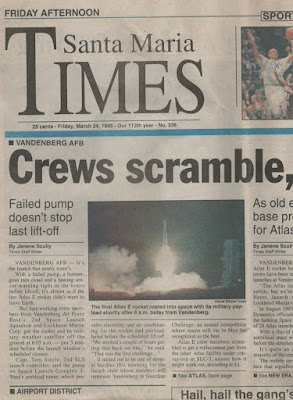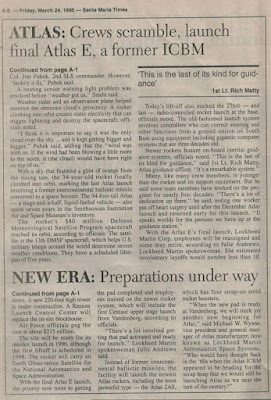This 1998 article was found in our collection of family memorabilia. I believe we have in our possession the "red taged pull pin" for this launch. This article reads as:
Santa Maria TIMES
Crews scramble, send Atlas
Failed pump doesn't stop last lift-off - by Janene Scully - Time Staff Writer
VANDENBERG AFB - It's the launch that nearly wasn't.
With a failed pump, a humongous rain cloud and a heating sensor warning light in the hours before lift-off, it's almost as if the last Atlas E rocket didn't want to leave Earth.
But fast working crew members from Vandenberg Air Force Base's 2nd Space Launch Squadron and Lockheed Martin Corp. got the rocket and its military weather satellite off the ground at 6:05 a.m. - just 3 minutes before the launch window's scheduled closure.
Capt. Tom Steele, 2nd SLS launch controller, said the pump on Space Launch Complex 3-West's umblical tower, which provides electricity and air conditioning for the rocket and payload, failed before the scheduled lift-off. "We worked a couple of hours getting that back on line," he said, "That was the first challenge..."
It turned out to be one of several hurdles this morning for the launch crew whose members will represent Vandenberg in Guardian Challenge, an annual competition-where teams will vie in May for recognition as the best.
Atlas E crew members scrambled to get a replacement part from the other Atlas facility under conversion at SLC-3, unsure how it might work out, according to Lt.
____________________________
ATLAS: Crews scrambled, launch final Atlas E, a former ICBM
Continued from page A-1
Col. Jim Puhek, 2nd SLS commander. However, "luckily it fit," Puhek said.
A heating sensor warning light problem was resolved before "weather got in," Steele said.
Weather radar and an observation plane helped monitor the ominous cloud's proximity. A rocket climbing into orbit creates static electricity that can trigger lightning and destroy the spacecraft, officials noted.
"I think it is important to say it was the only could over the sky... and it kept getting bigger and bigger." Puhek said, adding that the "wind was with us. If the wind had been blowing a little more to the north, it (the cloud) would have been right on top of us."
With a sky that featured a glint of orange from the rising sun, the 34-year old rocket finally climbed into orbit, marking the last Atlas launch involving a former intercontinental ballistic missile converted to a space booster. The 94-foot-tall Atlas - a stage-and-a-half, lilquid fueled vehicle - also spent seven years in the Smithsonian Institution Air and Space Museum's inventory.
The rocket's $80 million. Defense Meteorological Satellite Program spacecraft reached its orbit, according to officials. The satellite is the 13th DMSP spacecraft, which helps U.S. military troops around the world determine severe weather conditions. They have a scheduled lifespan of five years.
----------------------------------------------------
'This is the last of its kind for guidance' - 1st Lt. Rich Matty
----------------------------------------------------
Today's lift-off also marked the 276th - and last - radio-controlled rocket launch at the base, officials noted. The old-fashioned launch system involves controllers who can correct steering and other functions from a ground station on South Base using equipment including gigantic computer systems that are three decades old.
Newer rockets feature on-board inertial guidance systems, officials noted. "This is the last of its kind for guidance," said 1st Lt. Rich Matty, Atlas guidance officer. "It's a remarkable system."
Matty, like many crew members, is younger than the rocket and its support equipment. But he said some team members have worked on the program for nearly four decades. "There's a lot of dedication up there," he said, noting one worker put off heart surgery until after the December Atlas launch and returned early for this launch. "It speaks worlds for the persons we have up at the guidance station."
With the Atlas E's final launch, Lockheed Martin Corp. employees will be reassigned and some may retire, according to Julie Andrews, Lockheed Martin spokeswoman. She estimated involuntary layoffs would number less than 10.
---------------------------------------
As old era soared, base preparing for Atlas' future By Janene Souly
Times Staff Writer
VANDENBURG AFB - Even as the last Atlas E rocket headed toward history books, crews have been readying for a new era of Atlas launches at Vandenberg Air Force Base.
"The Atlas launch team will be quiet for awhile, but we're not going away," said Tom Heter, launch operations manager with Lockheed Martin Corp, at Vandenberg.
In August 1993, Air Force and then General Dynamics officials gathered to mark the end of the hulking Space Launch Complew-3 East, site of 28 Atlas launches between `961 and 1987.
With a flip of the switch, the SLC=3 East's umbilical mast was lowered for a final time, before the structure was demolished.
It's quite an undertaking to replace the majority of the site facility first built in 19600.
The mobile service tower, a tall white structure that signifies the launch complex, came
See NEW ERA, back page
NEW ERA: Preparations under way transcription
[Continued from page A-1]
down. A new 220-foot high tower is under construction. A Remote Launch Control Center will replace the on-site blockhouse.
Air Force officials peg the cost at about $215 million.
The site will be ready for its maiden launch in 1886 although the first liftoff is scheduled in 1998. The rocket will carry an Earth Observation Satellite for the National Aeronautics and Space Administration.
With the final Atlas E launch, the priority now turns to getting the pad completed and employees trained on the newer rocket system, which will include the first Centaur upper stage launch from Vandenberg, according to officials.
:There's a lot involved getting that pad activated and ready for launch," Lockheed Martin spokeswoman Julie Andrews said.
Instead of former intercontinental ballistic missiles, the facility will launch the newest Atlas rockets, including the most powerful type-the Atlas 2AS, which has four strap-on solid rocket boosters.
"When the new pad is ready at Vandenberg, we will mark yet another new beginning for Atlas," said Michael W. Wynne, vice president and general manager of Atlas manufacturer, now known as Lockheed Martin Astronautics Space Systems.
"Who would have thought back in the '60s when the Atlas ICBM appeared to be heading for the scrap heap that we would still be launching Atlas as we near the turn of the century?"
©All rights reserved by Pathways in Genealogy. 2018 - 2029. No part of this website/blog may be reproduced without the express written permission from the owner.




No comments:
Post a Comment